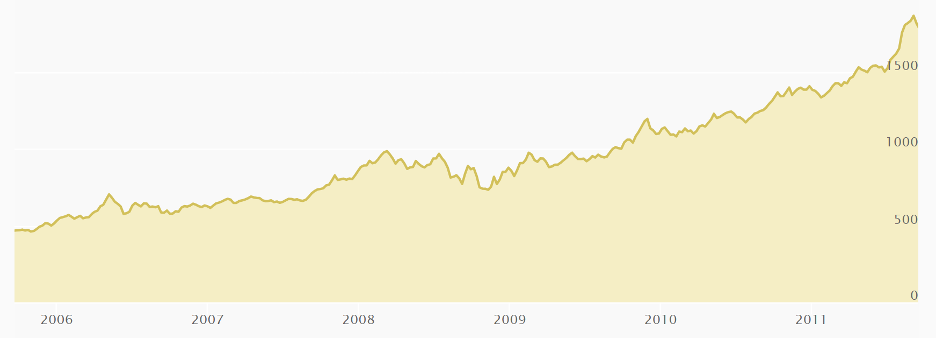In this exploration of gold prices over 30 years, we delve into key milestones, trends, and drivers that have shaped the precious metal’s journey, offering a comprehensive perspective on its historical performance and potential for the future.
Tracking Gold Prices Over 30 Years
On July 17, 1994, the spot gold price stood at $385. Exactly 30 years later, on July 17, 2024, gold prices reached $2,460, achieving a remarkable 538% gain. During this period, gold prices reached a low of $252.95 and a high of $2,468. The relative high of this 30-year time-frame represents the greatest value gold prices have ever reached, underscoring the yellow metal’s continuous rise over long periods of time. As the graph below clearly demonstrates, the trend of gold prices over 30 years has been up.

Notable Changes in the Gold Price Over 30 Years
The Late 1990s (1994-1999)
Between 1994 and the turn of the 21st century, gold experienced relatively subdued price action, characterized by overall stability with a minor downward trend.

During this time, central banks were net-selling gold due to a combination of powerful currencies and favorable economic conditions. Gold prices reached the lowest point in the past 30 years at $252.95 on August 26, 1999.
The Early 2000s (2000-2005)
Throughout the early 2000s, gold prices enjoyed steady upward momentum spurred by multiple hot wars in the Middle East and deteriorating economic conditions. The 9/11 attacks and eventual invasions of Afghanistan and Iraq sent shock-waves throughout the global economy, setting up markets for a shaky beginning to the new century. In between, the dot-com crash further destabilized the economy.

Altogether, these economic and geopolitical tensions drove gold prices from around $280 at the beginning of 2000 to well over $500 towards the end of 2005.
The Great Recession (2006-2011)
The Great Recession marred the economy of the latter half of the 2000s and the beginning of the 2010s. Although the recession technically ended in mid-2009, the economic repercussions were felt for years down the line. Gold’s reaction to the crisis would continue until it hit a record high of $1,901.34 on September 5, 2011.

Before the recession engulfed markets, gold had already notched a record-high above $700 on May 8, 2006, in response to concern over Iran’s nuclear program and the weakness of the US dollar. This short-lived peak was quickly overshadowed by a half-decade long surge throughout the global recession.
Post-Recession Recovery (2012-2015)
After reaching an apex in late 2011, gold prices entered a period of increased volatility with a steep downward trend. Overall, the value of gold went from just over $1,900 to a low of $1,053.80 on December 2, 2015, representing nearly a 45% loss.

Gold demand and, as a result, gold prices slumped during this period as the post-recession economy boomed. The Federal Reserve’s tightening of its monetary policy strengthened the US dollar and paper-backed assets. Investor demand for gold dropped significantly as the money poured into the traditional markets.
Mid-2010s Resurgence (2016-2019)
Following the years-long trough throughout the post-recession recovery, gold prices entered a period of consolidation and eventual growth. From the beginning of 2016 to the end of 2019, the yellow metal climbed from around $1,060 to $1,517.

The continuous ebb and flow of gold prices at the beginning of this period reflected the instability of the global economy. Investors weren’t sure what to make of Great Britain’s “Brexit” from the European Union or China’s economic woes. As uncertainty rose throughout the beginning of 2019, so did gold prices.
Modern Day (2020-Present)
Perhaps the most active period for gold prices over 30 years has been from 2020 to the present. The yellow metal kicked off the decade at $1,518 and recently notched an all-time record of $2,468 on July 16, 2024, nearly doubling in a matter of years.

The COVID-19 pandemic and ensuing recession triggered a tremendous rise in gold demand. Instead of entering a post-recession recovery, the economy remains unstable and uncertain
This volatile economic climate – besieged by domestic bank crises, high-interest rates, a declining dollar, and geopolitical conflicts – has kept gold buying at record highs.
Why the 30-Year Time Frame?
The focus on gold prices over 30 years might seem arbitrary, especially since the shiny history of gold’s value dates back millennia. However, three decades is quite a fitting timeline given that the average person starts investing at 33 years old. That leaves room for a little over 30 years of growth before people start dipping into their investment accounts after retirement age. Looking at the historical performance of gold within this appropriate timeframe can give current investors an idea of how gold might fit into their portfolio and contribute to their nest egg.
Where’s gold headed in the next 30 years?
Diving into the rise of gold prices over 30 years offers some crucial insights into the past, but where is gold headed over the next 30 years? With gold prices resting near all-time highs, many investors are wondering just that.
Although nobody can accurately predict the future, gold price forecasts suggest the yellow metal is going to outpace inflation. The longer the time frame, the more bullish experts become.
In fact, gold’s performance thus far in 2024 has already forced experts to raise their gold price forecasts. If the impressive rise in gold prices over the past three decades were repeated, the yellow metal would reach an evaluation of $14,755! That might seem like an unbelievably high evaluation, but the precedent has already been set.
Of course, the longer out one looks, the more speculative the projection. However, one thing is sure, the longer you hold gold, the higher the returns will be. This has been a truism for gold prices over 30 years and beyond.
👉 Related: Gold Price Charts – Compare to Dollar, Crude and Stock Market
Learn How to Invest in Gold with Our Free Guide
The upward trajectory of gold prices over 30 years pays testament to this yellow metal’s role as a hedge against inflation and economic uncertainty. If you’re eager to get the most out of your precious metal investments, grab a FREE copy of our Precious Metals Investment Guide. It’ll take you through everything you need to know about diversifying with gold and silver to protect your wealth for the next 30 years and beyond.


